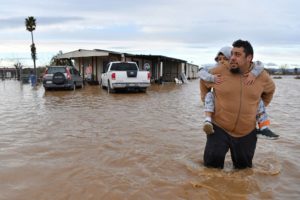While surveying the flood devastation in California’s coastal area on Thursday, Jan. 19, President Joe Biden was not about to miss the opportunity to take advantage of the ongoing situation by blaming it all on climate change. But is there any truth to his claim?
Biden Tours the Golden State’s Damaged Coast
 Several counties in California have suffered severely from the storms that began in December, including Merced, Sacramento (in the Central Valley), San Francisco, Santa Clara, and Santa Cruz. Together, these areas expect repairs to cost about $250 million, but the estimate is in the billions statewide. The president noted that his administration has already provided the region with $9 billion in disaster aid, but “There’s got to be significant changes made, and the federal government’s going to be here to help get that done.” He promised, “The federal government is not leaving its responsibility till it’s all fixed; it’s done.”
Several counties in California have suffered severely from the storms that began in December, including Merced, Sacramento (in the Central Valley), San Francisco, Santa Clara, and Santa Cruz. Together, these areas expect repairs to cost about $250 million, but the estimate is in the billions statewide. The president noted that his administration has already provided the region with $9 billion in disaster aid, but “There’s got to be significant changes made, and the federal government’s going to be here to help get that done.” He promised, “The federal government is not leaving its responsibility till it’s all fixed; it’s done.”
At Seacliff State Park, Biden said, “You don’t feel it until you walk the streets,” and added, “If anybody doubts the climate is changing, they must have been asleep for the last couple of years.” He warned that, as climate change worsened, we can expect to see even more serious weather events.
Any Truth to the Claims?
Most of the state’s water comes from a weather system known as “atmospheric rivers,” which, according to AP News, are “long, narrow bands of water vapor that form over the ocean and flow through the sky.” California was hit by several of these in short succession from Dec. 26 to Jan. 17 and saw an average of 11.47 inches of rain and snow.
Some regions got the worst of it. The Sierra Nevada experienced as much as 15 feet of snow, while other parts of the state were drenched by more than 30 inches of rain. An estimated 20 people have so far died from this season’s landslides and flooding. According to the Los Angeles Times:
“… rivers in Salinas, Merced and Sacramento counties swelled and spilled over their banks — turning farmland, whole city blocks and neighborhoods into lakes upon which first responders required jet skis, boats, kayaks and canoes to evacuate stranded Californians.
“And in the coastal mountains, from the Bay Area south to Ventura, drought-stressed trees fell across roads and houses — isolating entire neighborhoods — while debris flows, mudslides and sinkholes blocked traffic and spurred dozens of evacuations. More than 500 landslides were recorded across California in the last few weeks.”
The devastation is clearly significant, but does this mean climate change is to blame?
The Historical Perspective
“The first flood reported in California occurred on the Los Angeles River in 1770,” stated the California Extreme Precipitation Symposium. The first rainfall measurements were not recorded until 1847, and in 1850 the US Army started measuring rainfall in San Diego.
The Great Flood of 1862 was the largest in the state’s history, spanning California, Nevada and Oregon. The storm started in Oregon in November 1861 and continued into January 1862. In California alone, 4,000 people died, a third of the property was destroyed, and 25% of the cattle perished. “State legislators had to row to work at the Capital in Sacramento for several weeks before temporarily relocating to San Francisco, so that much of the city could be raised on average 10 feet,” what is known as the “underground city” in Old Town Sacramento today, according to AonEdge’s website.

(Photo by Jose Carlos Fajardo/MediaNews Group/East Bay Times via Getty Images)
During this Great Flood, San Diego received about 35 inches of rain, and in the foothills, in the mining town Sonora, the area received a whopping 102 inches, according to the National Weather Service. William H. Brewer of the Whitney California Geological Survey wrote of the Central Valley on Feb. 9, 1862, that “Nearly every house and farm in this immense region is gone. There was such a body of water 250 to 300 miles long and 20-60 miles wide, the water ice cold and muddy-that the winds make high waves which beat the farm homes in pieces.”
A report titled “Data on California’s Extreme Rainfall from 1862-1995,” written by Jim Goodridge, notes that there were 12 major storms listed from 1862 to 1899, and 58 recorded in the 1900s.
Political Games?
Is this a sign of climate change or a pattern of weather events that have been happening for at least two centuries? President Biden may believe that the recent loss of life and property damage is entirely caused by an increase in man-made emissions, but that ignores the long, troubled history of natural disasters in the region.
Philosopher and novelist George Santayana wrote: “Those who cannot remember their past are condemned to repeat their mistakes”. Wise words, indeed, for an administration bent on spending billions of taxpayer dollars on a problem it appears to have wilfully misconstrued.




